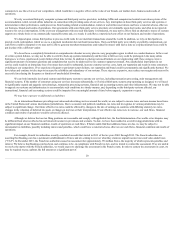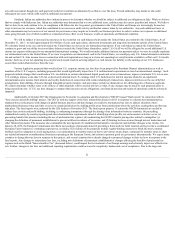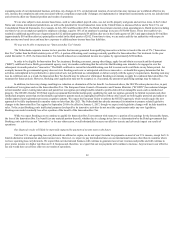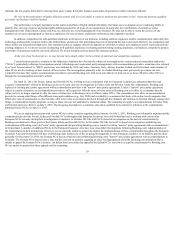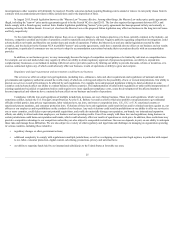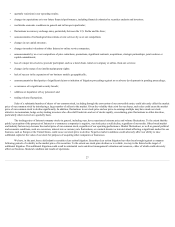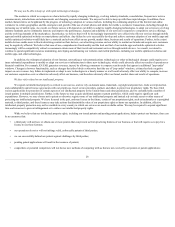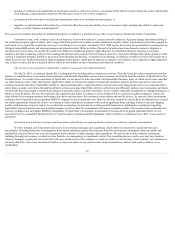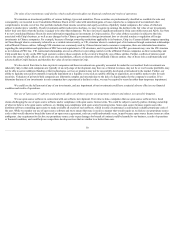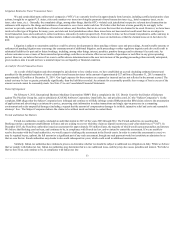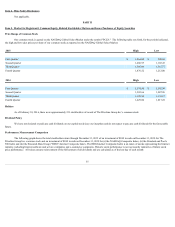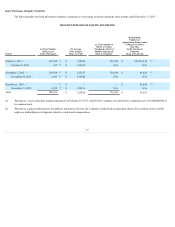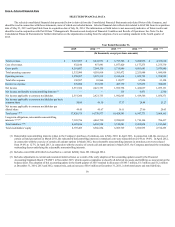Priceline 2015 Annual Report Download - page 33
Download and view the complete annual report
Please find page 33 of the 2015 Priceline annual report below. You can navigate through the pages in the report by either clicking on the pages listed below, or by using the keyword search tool below to find specific information within the annual report.
The value of our investments could decline, which could adversely affect our financial condition and results of operations.
We maintain an investment portfolio of various holdings, types and maturities. These securities are predominantly classified as available-for-sale and,
consequently, are recorded in our Consolidated Balance Sheets at fair value with unrealized gains or losses reported as a component of accumulated other
comprehensive income, net of tax. Our portfolio includes fixed income securities and equity securities of publicly traded companies, the values of which are
subject to market price volatility. If such investments suffer market price declines, we may recognize in earnings the decline in the fair value of our investments
below their cost basis when the decline is judged to be other than temporary. We have invested a significant amount in Ctrip convertible notes and ADSs. See Note
4 to our Consolidated Balance Sheets for more information regarding our investments in Ctrip securities. The value of these securities is subject to the risks
associated with Ctrip's business, as well as any changes by the Chinese government in foreign investment laws or elevated scrutiny or regulation of foreign
investments in Chinese companies. For example, because of foreign ownership restrictions applicable to its business, Ctrip is a Cayman Islands company operating
in China through what is commonly referred to as a variable interest entity, or VIE, structure where it conducts part of its business through contractual relationships
with affiliated Chinese entities. Although VIE structures are commonly used by Chinese Internet and e-commerce companies, there are substantial uncertainties
regarding the interpretation and application of PRC laws and regulations to VIE structures, and it is possible that the PRC government may view the VIE structure
as in violation of PRC law. VIE contractual relationships are not as effective in providing control over the affiliated Chinese companies as direct ownership, and
Ctrip would have to rely on the PRC legal system to enforce those contracts in the event of a breach by one of these entities. Further, conflicts of interest could
arise to the extent Ctrip's officers or directors are also shareholders, officers or directors of the affiliated Chinese entities. Any of these risks could materially and
adversely affect Ctrip's business and therefore the value of our investment in Ctrip.
We also invest from time to time in private companies and these investments are generally accounted for under the cost method. Such investments are
inherently risky in that such companies are typically at an early stage of development, may have no or limited revenues, may not be or ever become profitable, may
not be able to secure additional funding or their technologies, services or products may not be successfully developed or introduced to the market. Further, our
ability to liquidate any such investments is typically dependent on a liquidity event, such as a public offering or acquisition, as no public market exists for such
securities. Valuations of privately-held companies are inherently complex and uncertain due to the lack of a liquid market for the company's securities. If we
determine that any of our investments in such companies have experienced a decline in value, we may be required to record an other than temporary impairment.
We could lose the full amount of any of our investments, and any impairment of our investments could have a material adverse effect on our financial
condition and results of operations.
Our use of "open source" software could adversely affect our ability to protect our proprietary software and subject us to possible litigation.
We use open source software in connection with our software development. From time to time, companies that use open source software have faced
claims challenging the use of open source software and/or compliance with open source license terms. We could be subject to suits by parties claiming ownership
of what we believe to be open source software, or claiming non-compliance with open source licensing terms. Some open source licenses require users who
distribute software containing open source to make available all or part of such software, which in some circumstances could include valuable proprietary code of
the user. While we monitor our use of open source software and try to ensure that none is used in a manner that would require us to disclose our proprietary source
code or that would otherwise breach the terms of an open source agreement, such use could inadvertently occur, in part because open source license terms are often
ambiguous. Any requirement to disclose our proprietary source code or pay damages for breach of contract could be harmful to our business, results of operations
or financial condition, and could help our competitors develop services that are similar to or better than ours.
30


